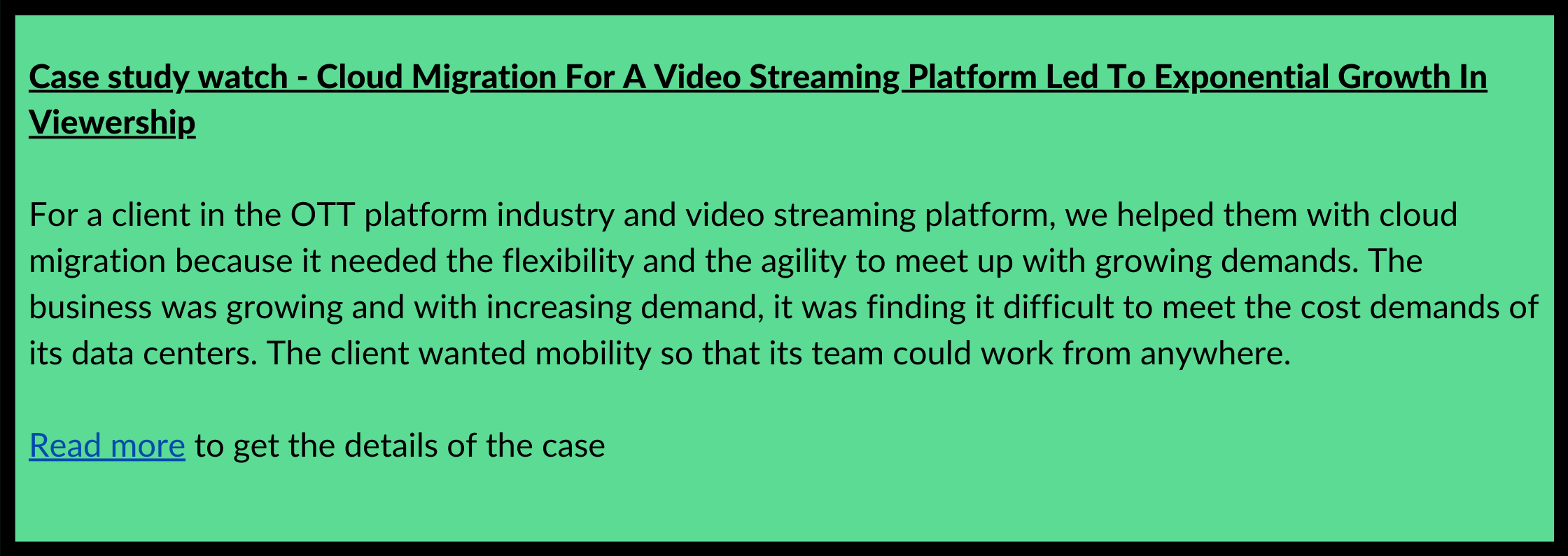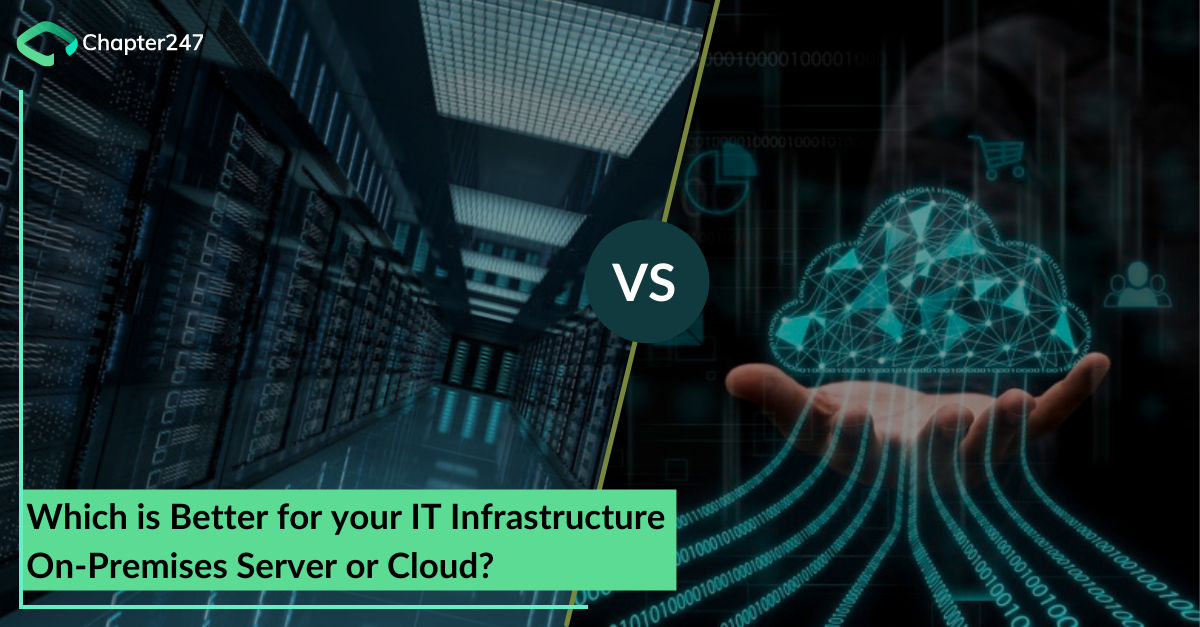infrastructure on premiseYes, many enterprises find it difficult to decide between the two. They want to know if it’s worth moving their technological infrastructure onto the cloud. These companies fear that it is not equal to ‘out of the frying pan into the fire situation’ mainly because they are not aware of the differences as much as they should know. So in order to clear the cloudiness in your judgment, you have to ask,” Has your business been operating an old, outdated server system?”
You obviously prefer the right server for your business instead of a failed server that can result in disaster. If you are looking at a new business server then you need to choose between online cloud-based servers or traditional on-premise servers. There are trade-offs to whatever option you choose, so do not act without information before you decide what option to take.
There are several elements that go into on-premises and cloud systems and to narrow it down, you have to focus on the differences between their core elements. Ultimately it is a choice you need to make based on the needs of your business but whatever that is, it has to be informed.
On-premises vs Cloud
Cloud computing has grown in popularity and it has benefitted many in the long run. Its applications have offered organizations with newfound flexibility and benefits right from saving time and money to improving agility and scalability. On the other hand, on-premise software which is installed on a company’s own servers and is present behind its firewall serves business needs but only to a point. But on-premise applications are no doubt reliable, secure, and allow the organizations to maintain a certain level of control which even the cloud cannot. Yet it is important to compare them and understand the rationale behind each.
On-Premise
Data security is one of the most important factors to take a decision whether it is cloud or whether it is on-premises. On-premise software requires that an enterprise purchases a license or a copy of the software to use it. Since the software itself is licensed and the software resides within the premises of the enterprise, there is a much more perceived sense of protection compared to that of cloud computing infrastructure.
On-premise, therefore, means the software and a hardware infrastructural set up which is deployed and running from within the confines of your organization. In such a setup the organization will have complete control over the infrastructural setup. Data stays in the private network and nobody other than the team has access to information. The downside of the on-premise ecosystem is that the costs associated with managing and maintaining all the solutions can run exponentially higher than a cloud computing environment. It requires in-house server hardware, software licenses, integration capabilities, and IT employees on hand to support as well as manage whenever any major issues arise.
Pros
- On-premise gives you physical control over your server and it keeps critical data in-house. No third-party can take control and has access to your information.
- There is no need to rely on any internet connection in order to access the data.
- For those companies which are concerned about uptime, preferring an on-premise solution can be very cost-effective.
- Cons
- It requires a major capital investment in hardware and infrastructure.
- It also requires excessive space in your office for rack space or server room/closet as well as a dedicated IT support.
- Data security becomes vulnerable. It is more susceptible to data loss especially during disaster situations in the location where it is stationed. Your data becomes prone to getting lost especially whenever you decide to take it offsite.
- Also, there are no uptime guarantees
Cloud computing Infrastructure
A cloud computing network different from on-premises software in an important way. In a cloud environment, a cloud-service provider like us hosts everything for the organization. The organizations can pay on a need basis and scale up or down depending on the overall usage, requirements, and growth of the company.
A cloud-based server utilizes virtual technology to host a company’s application offsite. There are no capital expenses, data also can be backed regularly, and the company only has to pay for what they use. For those organizations that are planning to aggressively expand on a global basis, the cloud has a greater appeal because it allows the organizations with customers, partners, and other businesses anywhere with very little effort.
Pros
- There is no need for onsite hardware or capital expenses. This is well-suited to rapidly growing companies that are looking forward to outgrowing their infrastructure quickly.
- The entire architecture is scalable, which means that you can scale up and down depending on the needs and demands of your business. You only pay for the options you want.
- Workers can connect from anywhere using their respective devices. Companies can also implement BYOD policies.
- Data can be backed up in the cloud with great regularity even in 15-minutes intervals thereby minimizing data losses.Cons
- The user experience is limited by the speed of the internet connection.
- Third-party cloud services could have direct access to your data.
- If the Internet goes down on your side or on your cloud provider’s side, you won’t have to access any of your information.
- The cost can outweigh the benefits for companies not as dependent on uptime.
Let’s compare the key differences
1.Deployment
On-Premises: In an on-premises environment, resources are deployed in-house and within an enterprise’s IT infrastructure. The enterprise will be responsible for maintaining the solution and all the processes related to it.
Cloud: Cloud computing comes in different forms namely public, private, and a new popular- hybrid cloud. In a public cloud computing environment, resources are hosted on the premises of the service provider, Enterprises are able to access those resources and use them as much as they want at any given point in time.
2.Cost
On-Premises: For those organizations that deploy software on-premise, they will be completely responsible for the ongoing costs of the server hardware, power consumption, and space.
Cloud: Those organizations that avail the services of a cloud computing provider has to pay only for the resources that they use. There is no upkeep and maintenance costs and the price adjusts up and down based on how much the organization uses up the service.
3.Control
On-Premises: In the case of on-premises environments, the enterprises retain all the data and are in complete control of what happens to it. Those companies which are from highly regulated industries where privacy concerns are likely to hesitate to take a leap into the cloud.
Cloud: In the case of a cloud environment, the point of data ownership is one that many organizations and the vendors have actually struggled with. Data and encryption keys are present with third-party providers, hence if the unexpected takes place and if there is any downtime face, you may not be able to access the data.
4.Security
On-Premises: For those companies which are expected to withhold a sense of security especially those who are in the government or banking industry, security can be a primary concern in the case of cloud. In that case, having it on-premise makes far more sense compared to that of the cloud.
Cloud: Security concerns still are the biggest barrier to the deployment of Cloud. There have been many security breaches when it comes to the public cloud and there is a growing concern about this. From personal information of employees such as login credentials to a loss of intellectual property, security threats are for real.
Chapter247’s Cloud computing solutions
Every company needs to embed a scalable infrastructure that can support faster and secure file transfer, end-to-end visibility, and support for any hybrid integration.
Regardless of what kind of environment you are looking for, whether that’s to add a software-as-a-service (SaaS) solution to address a specific business need, move processes and data into a cloud integration platform, or whether you are a SaaS organization that thrives on delivering faster responses to customer requests, you rely on integration to make your data ground-to-cloud and cloud-to-cloud integration processes to easily integrate applications.
We deliver cloud-based SaaS solutions to achieve high levels of access and permit your web-based enterprise to develop rapidly and also scale to a greater extent to meet customer demands. We also incorporate third-party self-scaling IaaS cloud platforms in order to ensure your application has a great network performance and automated resource scaling whenever required. We also provide cloud migration solutions to overhaul your solutions, optimize the contributions with multiple perspectives.
 Contact Chapter247 to learn more about integrating the critical on-premise and cloud applications running your business
Contact Chapter247 to learn more about integrating the critical on-premise and cloud applications running your business








